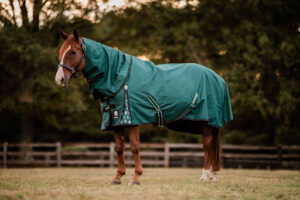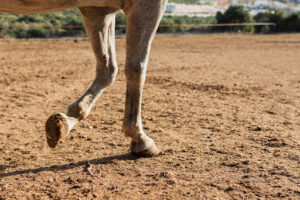How to Prepare for Horseback Riding Outdoors
Ever have one of those days where it seems like the arena just gets smaller and smaller? Maybe you and your horse have been cooped up due to bad weather, or you’ve been training so hard to get to the next level in your competitive aspirations that you’re a little burnt out. A proper hack […]

Ever have one of those days where it seems like the arena just gets smaller and smaller?
Maybe you and your horse have been cooped up due to bad weather, or you’ve been training so hard to get to the next level in your competitive aspirations that you’re a little burnt out.
A proper hack might be just what you and your horse need. Riding outdoors has tons of benefits, from renewed focus and energy to improving your balance and horsemanship skills.
Galloping through an open field is exciting, but it’s not as simple as “get on and go”. For an inexperienced rider or a strong or nervous horse, riding outside of the confines of a ring or arena can be potentially dangerous.
To help ensure a fun, safe hack for both horse and rider, you’ll want to make sure you’re prepared before you take to the trails or fields. Here’s how to prepare your horse and yourself for riding outside this season.
Getting your Horse Ready to Ride Outside
Horses are designed to be outside, but that doesn’t necessarily mean he’s accustomed to being ridden outside. Horses are herd animals and draw comfort from the presence of other equines. Being ridden out alone can be an anxiety-inducing experience for a horse, especially one who is young, inexperienced, or has a tendency to be “buddy sour” (gets upset when separated from a favorite pal or herdmates).
A young or nervous horse may benefit from an older, calmer, or more experienced companion. The same goes for you, as well. You may enjoy the company, and the expertise of a more experienced horse person if your horse gets stronger or spookier than expected.
A critical aspect of preparing your horse to ride comfortably and confidently outside is desensitization. Everyday things like bushes, the wind in the trees, or just an unfamiliar shadow can cause a horse to spook, so desensitizing him at home is important for helping ensure a safer ride.
Start with plenty of hand walks around the outdoor areas of your barn or trails. Work on fun desensitization exercises like walking over and under a tarp, over bridges, or through water. For some great desensitizing exercises, check out Equinehelper’s Ultimate Guide to Bombproof and Desensitize a Horse.
Better yet, practice learning how to open and close gates without dismounting. If you’re riding through fields, this will be an indispensable skill that can save you tons of mounting and dismounting, something your horse’s spine will thank you for.
Training yourself
Your ring mount may need to develop a few skills before heading into the great unknown, and you’ll probably benefit from some practice sessions, too. Fortunately, there’s a lot you can do in the ring.
Trotting poles, cross rails, small jumps, and even awkward distances can help you prepare for the uneven terrain you may face outside. Maintaining your two-point at the walk and trot can develop muscles you’ll need to call upon to get off his back and help him navigate tricky trails.
Transitions, including walk/trot, trot/canter, walk/canter, canter/walk, and canter/trot can help you prepare for last-minute speed adjustments, as well as getting your horse out of his regular “training zone” and listening to your aids.
When it comes to training yourself, take the same “little and often” approach that you take with your horse. You’re looking to enjoy a good hack, not necessarily become the next endurance champion, so make sure to go easy on yourself and give your body time to recover, too.
Essential Equipment
One final thing before you take to the trail is to ensure that you and your horse are properly outfitted and prepared.
Even if you’re just on a quick jaunt around the property, make sure you’re wearing a helmet, your tack is in safe condition, and bring your phone in case of an emergency. A pair of breeches with a phone pocket can keep your phone handy, without it getting in the way.
For longer rides, dress yourself and your horse for comfort. Try an ear bonnet to keep insects out of his ears, or a fly mask to keep bugs out of his eyes. If your horse is a bit nervous or has a tendency to spook, earplugs can help muffle scary sounds, like traffic or lawnmowers. Pack a small horse/ human first aid kit for emergencies. A saddle pad with a pocket is a great option for stowing your outdoor essentials.
Check the weather forecast before you head out, too. Dress in light layers, and expect the outside temperature to be a bit different than the indoor arena. In the summertime, bug spray for both of you might be a necessity, and you might want to wear sunglasses (ideally with shatter-proof lenses) to avoid squinting and eye strain.
If you’re expecting wet conditions, leave the polo wraps at home, as wet polos quickly get muddy, heavy, and can be dangerous if the velcro comes undone. If he must have legwear, opt for easy-clean neoprene boots, if possible.
Better Safe Than Sorry
Most importantly of all, be very mindful of the footing.
Avoid muddy or slippery areas, especially hills, if you can. Please be very cautious if riding through underbrush, as there can be gopher holes, exposed tree roots, rocks, hidden logs, and any number of things that can cause your horse to fall, twist a leg, or worse. If you don’t know what you’re asking your horse to walk through, you probably shouldn’t be riding through it.
While your horse’s night vision is much better than yours, riding at night is generally not a good idea. If your route may keep you out past dusk, consider reflective accessories or a blinking tail light, especially if you’ll be on roads or shared trails.
Happy Trails!
Riding outside is the perfect way to connect with your horse, enjoy some fresh air and time in nature, and to help improve your riding and horsemanship skills, too. Whether you need a mental break or are just looking for a fun activity to try with your horse, making sure you and your horse are ready for the great outdoors is essential to ensuring a happy hack.
What is your #1 can’t-go-without accessory when it comes to riding outside? Share your wisdom in the comments below.








